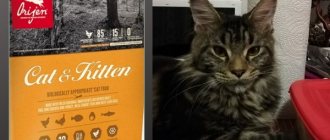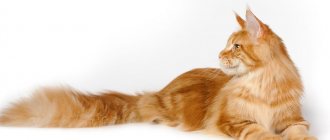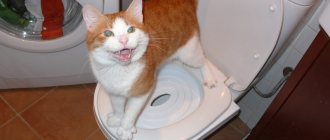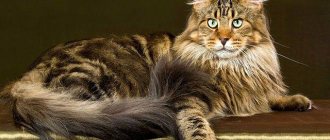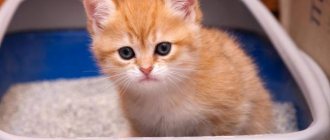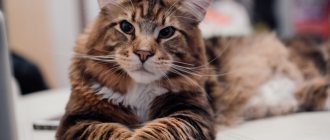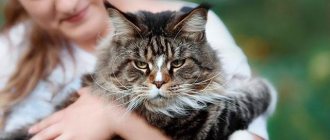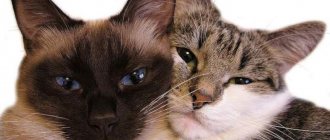Maine Coons are distinguished by their large size and playful, active character. Therefore, choosing a suitable tray for cats of this breed may not be so easy. as if we were talking about a smaller pet. What are the options for trays and litter for Maine Coons and how can you choose from all their variety the one that your cat will be happy to use?
And is it possible to quickly and easily teach a Maine Coon kitten to use the cat litter box intended for it, and not leave puddles and piles in places not intended for this?
Kinds
Nowadays, you can easily choose a tray for a cat, since their range is very diverse in terms of design and color, so it’s not difficult to choose a tray that matches the color of the interior of the room where it will be placed. But in order to choose the right litter box for your Maine Coon, you need to know the advantages and disadvantages of each type of litter box.
Since adult cats of this breed are large in size, they need a fairly large tray, the minimum dimensions of which should be 40x80 cm.
Rectangular with low sides
Almost all other cats can use this litter box successfully.
But it is completely unsuitable for adult Maine Coons.
After all, these cats love to dig up litter.
Because of this, the granules will scatter far from such a tray every time your pet visits it.
For a small kitten of this breed who is just beginning to learn the “wisdom of the toilet,” such a tray will be very good. Kids are not afraid of its appearance, and the low sides allow the kitten to use it independently.
With high sides
Trays of this design often have additional sides that increase their height even more. For Maine Coons, such a tray is quite acceptable, since the high sides prevent the litter from scattering even if the pet vigorously rake it. In addition, cats like litter boxes with high sides as they create the illusion of an enclosed space and make them feel confident and safe.
For Maine Coons, trays with sides and a height of at least 10 cm are suitable.
Closed house
It is a closed structure that resembles a carrier in appearance and is equipped with a hinged door on the side.
One of the advantages of this design is that there is almost no unpleasant odor in the house from such a cat litter box.
After all, trays and houses are often equipped with carbon filters that absorb animal odors. Cats, as a rule, willingly use such trays, since in the toilet-house nothing distracts them from the process.
The disadvantages of closed toilets include their high price compared to other trays and the fact that they are inconvenient to clean if the tray does not slide out or if the top part cannot be removed from them.
Therefore, if you decide to buy a closed type tray, in the form of a house, then you need to choose the model that has a removable top or the one that is equipped with a retractable tray.
DIY cat house and scratching post
The design of the future cat shelter for the Maine Coon can be chosen from the following options:
- An ordinary rectangular house is a simple shape, easy to design and manufacture.
- Round, made from scraps of large diameter pipe.
- A castle for a Maine Coon is a fantasy project with decorations and additional elements in the form of stairs, passages, and a jagged roof.
Important information! Some Maine Coon owners are considering decorative options for a house with a scratching post, the development of which will require both imagination and time. In this case, the cat can be placed in a wigwam, a fabric tunnel or a wicker basket.
Tools and materials for a house with a scratching post
To work on the project for a Maine Coon house with a scratching post you will need:
- Electric jigsaw or hand saw.
- Drill, screwdriver.
- Glue gun or regular glue.
- Large ruler or tape measure.
- Scissors and a sharp knife.
It’s good when, among other things, there are clamps, and for complex woodworking a hand router is useful.
It is preferable to choose materials for a house with a scratching post that are not the most expensive, but strong and natural.
- Thick fabric for covering internal and external surfaces.
- Pipe (ø 150 mm), timber 150x150 mm or a size close to this.
- Lots of thick rope.
- The material for the house and base is plywood, chipboard or thick cardboard (for the house only).
- Metal corners for rigid fastening of elements.
- You may need round or square brackets (if the scratching post is connected to the house, depending on the base - a round pipe or a rectangular beam).
- Self-tapping screws.
- Insulating tape.
- Furniture stapler.
- Ruler, pencil.
Instructions for making a house and scratching post for a Maine Coon
To create a Maine Coon house, you need to determine the dimensions of the future structure and make cuts in accordance with the drawings.
- The base – 650x900 mm is cut out of plywood. If additional fastening to the floor with self-tapping screws is not intended, use a material at least 15 mm thick.
- The walls of a rectangular house (4 pcs.) - all elements are 500 (height) x 600 (width) mm.
- Roof – 600x600 mm.
Holes (about 200x200 mm) are made in the front and one side wall for the Maine Coon to enter the house.
The rectangular box is assembled along the walls with self-tapping screws, twisted into corners or using connecting strips. The upper part of the box necessarily contains a strapping of slats, which serve as a stop for the lid. It should be removable, opening the internal space for cleaning and disinfection. Regardless of the size of the house for the Maine Coon, it is necessary to provide free access to their “living” part.
The scratching post is made from a plastic pipe or wooden beam. Both materials are strong enough to withstand the pressure of a large cat, which will lean on the structure with its entire weight.
- Cut to desired size. If we are talking about installing a separate element, then its length must be at least 1 meter.
- Attach 3-4 metal corners to the pipe below. They will be needed to connect the scratching post to the lower platform. If a wooden beam is used for the base, then no problems arise in this place. And in thin pipe walls, self-tapping screws do not hold well and can become loose over time. Therefore, it is recommended to cut small wooden overlays, place them inside the pipe and screw screws into them. The threads pass through the plastic and into the durable wood, strengthening the entire assembly.
- If you plan to create an observation deck on the top of the Maine Coon scratching post, you need to make a similar fastening on both sides.
- In projects that involve an additional connection between the house and the scratching post, round (for pipes) or rectangular (for timber) brackets should be strengthened at a level of 350-400 mm.
- Seal the end of the rope (wrap it) with electrical tape or tape and screw it into the bottom of the pipe (beam) with a self-tapping screw. This precaution will prevent the edge of the rope from unraveling, and the connection of materials will be durable.
- Another way of attaching the same thing is to drill a hole along the thickness of the rope, pass its tip into the hole and tie a thick knot on the opposite side. It will prevent the cord from coming back out and will keep it taut.
- Wrap the entire length of the scratching post tightly with thick rope. Carefully close the areas where the corners and staples are located. There should not be a single millimeter of free space left, then the turns will fit tightly to each other over the entire surface.
- At the top level of the scratching post, the rope is again wrapped with electrical tape and screwed to the support with a self-tapping screw (or a hole is prepared and the second fastening method is used).
There is another clever way to secure the edge of a rope to a scratching post without any additional materials. At a distance of 30-40 cm to the edge, a doubled loop of strong thin wire or thick fishing line is placed under the turns of the cord.
Its two free ends should remain 20-30 cm below, and the fold should remain above the level of the scratching post. Next, they continue to apply tight turns to the very top. The end of the cord with a margin of 10-15 cm is passed through a wire loop and pulled towards the floor by the lower free ends. Even with a very strong tension on the cord, it is not necessary to apply much effort; a thin wire begins to come out from under the rope braid, and its upper part pulls the tip of the cord into the space between the base of the scratching post and the wound top layer.
Thus, the edge of the rope is completely hidden, and the wire comes out freely without disturbing the integrity of the turns.
All that remains is to cover all the elements of the house with fabric. Experts advise using simple one-component formulations. They are applied in a thin layer to the surface so that no air bubbles remain under the material. Once the cat feels that it can tear off a piece of the rag, it will not stop until it gets its way. Therefore, you need to glue over the entire plane, leaving no voids.
The final stage is screwing the Maine Coon house to the stand. Small holes should be made in the fabric in advance to the size of the fastener so that unpresentable metal parts are hidden under the covering.
Fillers
No less important than the design of the tray is the filler for it. Not only whether the cat will willingly use its litter box or will avoid it, but also the pet’s health status depends on how high-quality and safe it is for the animal. What types of cat litter are there and what are their pros and cons?
Silica gel
They are synthetic granules. This is a rather expensive type of filler, but it is used sparingly and lasts a long time.
Used silica gel fillers should not be flushed down the toilet for disposal.
You also need to remember that if they are used for a kitten’s toilet, then you need to carefully ensure that the pet does not play with the granules of such a filler and does not accidentally swallow them. Since they pose a danger to animals if they enter the stomach.
Clumping
Absorbs moisture perfectly, while collecting into lumps. This type of filler is changed once a day, and it is enough to remove only the part that has clumped into clumps, and then add a little fresh one. Its advantages include cost-effectiveness, lack of odor, ease of cleaning and safety for the animal, which allows the use of clumping type litter even for kittens. The disadvantages include the fact that such filler is not cheap, and also the fact that from a tray that is not equipped with a mesh, it will constantly be carried around the house on the animal’s paws.
Absorbent
After the cat uses the tray, the appearance and structure of this mixture does not change. It absorbs liquid well and retains animal odors. This filler is inexpensive, but it is also the most uneconomical. It has to be changed, albeit not every day, but completely. In addition, if it has been used even halfway, the Maine Coon may refuse to use the litter box.
There are types of absorbent litters designed specifically for kittens.
Necessary for a comfortable Maine Coon life
Let's start with the basic essentials for a Maine Coon, the basic necessities, so to speak. This may include
- tray;
- filler;
- toilet scoop;
- bowls.
All this should already be in the house before the arrival of a small or not so Maine coon.
cat litter
Trays for cats come in different varieties. Simple with a mesh, without a mesh, with sides, corner, on high legs, toilet training, dry toilets, automated. But a closed toilet house is best suited for a Maine Coon.
This toilet has several advantages. Firstly, the cat is more comfortable in it, and therefore she quickly gets used to it. Secondly, if you use litter, the cat will not be able to scatter it within a radius of the tray, as happens with regular litter boxes. And thirdly, usually such toilets are equipped with filters that retain the odor, preventing it from spreading throughout the living space.
Enclosed litter boxes for cats have a door. But if desired, it can be easily removed. Another very important point is the size of the tray. When you buy a kitten, there seems to be no point in buying a large litter box. But this is not so, soon your kitten will grow into a rather large animal that can hardly fit into a small toilet. Therefore, if you do not want to waste money, it is better to immediately buy a toilet for your cat “for growing up”.
Cat litter
Filler is also a very important moment in a cat’s life. Fillers vary in quality and price. Firstly, when purchasing a kitten, you need to check with the breeder what the kitten was trained to do in the nursery. It may also be that the kitten was trained to go to the tray without filler, or the filler was under the mesh. In this case, the life of the new owner is greatly simplified; he only needs to choose a good toilet for his pet.
But if the kitten has been accustomed to the litter, then most likely he will no longer go to the net or just to an empty tray. Therefore, you will have to choose the best filler for you and your pet.
Little secret. If you want to avoid problems with litter training your kitten in your new home, ask the breeder for some litter from the litter box the kitten used. Next, this filler is placed in the tray where it is planned to accustom the kitten.
When moving to a new home, a small Maine Coon experiences stress, all the smells are unfamiliar to him, and there are no parents or brothers nearby, so it is often difficult for him to immediately remember where the dining area is and where the toilet is. But if he smells a familiar smell, he will immediately figure out where to go to the toilet.
So, there are different types of fillers:
- clumping;
- absorbent.
They also differ in the type of materials from which they are made.
- woody;
- mineral;
- silica gel;
- made of concrete clay.
Clumping litters are suitable for owners of small numbers of animals. Its principle is that the liquid is absorbed into the filler, forming a lump that can be easily removed with a scoop.
But if there are several animals, such lumps, without having time to dry, can be loosened by the next cat who is about to visit the toilet. In this case, an absorbent filler is suitable, which retains moisture in the bottom layer.
The most optimal, in our opinion, is wood filler. It perfectly absorbs moisture, retains odor excellently, has a low price and is both absorbent and clumping.
What is important to know. It is strictly forbidden to bring soil or sand from the street. This litter can contain a lot of different infections that are dangerous for both cats and humans. Therefore, in order to protect yourself and your pet, we strongly recommend not to use “natural” fillers.
Cat litter scoops
If you use litter, scoops should also always be on hand. Moreover, it is better to have two different scoops, regardless of what filler you use. The first is continuous, to replace the entire filler, or part of the wet filler. The second is a scoop-strainer for removing excrement. Such a scoop only captures what needs to be removed, while clean filler falls back into the tray through the holes made in the scoop.
Bowls for food and water
Next we'll talk about food and water supplies. It would seem that this is a completely simple question: it is worth buying a bowl for a cat or selecting a cat bowl from a set of household dishes. The situation with Maine Coons is somewhat different. Maine Coons are indigenous animals.
In the wild, before they begin to absorb water from a reservoir or puddle, they are accustomed to raking it of all kinds of contaminants (leaves, twigs, and so on). This habit is genetically passed on from generation to generation.
Now, being domesticated, Maine Coons continue to rake water. Therefore, bowls of water are often knocked over or moved all over the floor. To avoid this, the bowls must be either quite heavy or fixed. Also, the bowl should be at a sufficient distance from the bowl of food so that the latter does not get wet and turn into mush.
There are also automatic drinkers, which are very convenient for people who are often not at home. After all, a cat should always have access to water.
Next comes the category of accessories that you may not have at home on the first day a kitten appears in it, but which you need to purchase in the first weeks. These are things like
- toys;
- scratching posts;
- combs.
Kitten toys
Maine Coon loves toys exactly the same as cats of any other breeds. Toys serve as a very important tool for the harmonious development of a kitten, especially if there are no peers in the house. Toys also help to establish contact with the kitten.
The range of toys in pet stores is amazing, so you won't find it difficult to choose. The favorite toys for the Maine Coon are mice, especially rustling ones, balls, including those on a spring, and of course the most favorite is a fishing rod with feathers, and if you buy a teaser fishing rod not just with feathers, I have feathers on a string, Maine Coon will arrange a real hunt.
In addition, such fishing rods require your participation, which means that you will enjoy the game with pleasure. Although you can play together with mice. Maine Coons will often bring the mouse to you so you can throw it again.
Maine Coons love to play not only when they are kittens, but throughout their entire lives, so stock up on toys for your pet. And he, in turn, will delight you with his fun games.
You should know that the use of toys made from scrap materials is undesirable (foil, paper, candy wrappers), because in the excitement a Maine Coon can eat such a ball, which can lead to intestinal obstruction or volvulus.
Scratching posts and comfort items
Scratching posts and complexes are also very important for the Maine Coon. And especially for its owner. After all, a cat will always find a place to sharpen its claws, but so that this does not come at the expense of furniture and carpets, it is better to purchase a special piece of furniture for your pet.
If you are not ready to spend money on a gaming complex, then a simple scratching post is a must-have in your home. They learn quickly and quite easily; for starters, you can buy a training scratching post soaked in a special solution.
Well, if you want to please your kitty, maybe not right away, but buy a gaming complex for her. They are small and inexpensive. The complex includes everything that a cat loves so much: houses, scratching posts, toys, beds (including hammocks), tunnels.
All this, of course, can be purchased separately. But will a separately placed house or bed become a cat’s favorite? From my own experience I can say that this is not always the case. But not a single cat has ever felt indifferent to the play complex.
Combs, brushes
Combs and grooming products. The Maine Coon, as you already know, has very long hair. Therefore, it requires special care. We will tell you in detail about how to care for Maine Coon fur in a separate article. And here you will find out what combs and products you must have in the house where the Maine Coon lives.
I strongly advise against using a slicker brush to comb your Maine Coon's fur. Such a brush has a very negative effect on the condition of the Maine Coon’s coat and skin.
And there are three types of combs to buy. Instead of a slicker, use a rake comb, which will remove all dead fur during shedding. For daily use to prevent tangles and tangles, a double-tooth metal comb with rare and frequent teeth is well suited. For the tail and belly, a brush with natural bristles or gentle teeth is suitable.
There are also special tools for removing mats from cat fur, but with proper care they should not occur at all.
Nail clipper, claw tips
Maine Coons, like all cats, have sharp claws. From time to time, especially if you exhibit an animal, or there are small children in the house, or if you often like to play with your pet, and also in order to avoid damage to furniture, clothes, etc., your pet’s claws need to be trimmed.
The procedure is quick and simple. There are special nail clippers for this, which you can also find in any pet store. Well, if you are afraid to trim your claws or don’t want to, stores have silicone tips for cat claws for you.
You can read about the procedure for trimming a cat’s claws in the “Maine Coon Care” section.
Essentials for a cat's health
And now we will talk about what is necessary for the health of a cat. These are usually vitamins and hair removal paste. Let me make a reservation: if you feed your cat super premium food, it usually contains elements for hair removal and a complex of vitamins. But this is not always the case, so if the food does not contain everything you need, then it is better to give it separately.
Vitamins and microelements
Vitamins and microelements are vital for a cat throughout its life for proper development, and subsequently for maintaining good health, strong teeth, and a healthy coat.
To provide your cat with the vitamins and microelements it needs, you don’t have to buy it all separately. Now there are excellent vitamin complexes that contain everything a cat needs.
I will not describe all the supplements available on the market. Any pet store will advise you on a good complex for your Maine Coon. You just need to know that the Maine Coon must receive such supplements. Especially during periods of molting, pregnancy, stress, illness, growth.
In turn, supplements are very important for the development and strengthening of Maine Coon joints. The Maine Coon is a very large animal. Its bulk puts stress on the paws, so when choosing a complex, take this point into account.
Hair removal paste
The next mandatory item for a Maine Coon is the presence of paste in the house to remove hair from the cat’s body. Maine Coons are clean animals that take strict care of their fur coat and lick it periodically. A huge amount of wool gets into their body.
The cat’s body cannot always cope with the amount of wool it absorbs on its own. Therefore, to prevent troubles such as constipation, gastric obstruction, cough, the Maine Coon must be given a special paste to remove hair from the body. Especially during the molting period. There are also a lot of varieties of pastes.
There are pastes for daily use, and others that last longer. A pet store consultant who will tell you in detail about each type of paste will also be happy to advise you on the best option.
Organic
They are made from natural materials, mainly compressed sawdust. This filler is safe for cats and is not changed too often - once or twice a week. Organic filler, with the exception of some of its types, is inexpensive and is sold in any pet store and even in grocery supermarkets in the pet products departments. There are no disadvantages to high-quality wood filler, except for the fact that small particles of shavings from which it is made can be carried throughout the house on your pet’s paws.
In addition to wood, there is also a filler made from the inside of corn cobs. It absorbs odors and liquid well, but it can also emit an unpleasant aroma for the cat. In addition, due to the fact that the corn litter granules are very light, it is easier than other types of cat litter mixtures to be thrown out of the tray and carried around the house on the paws of the Maine Coon. This type of filler is somewhat more expensive than wood filler, and is much less common on sale.
Selecting a location
Considering that a Maine Coon litter box takes up quite a lot of space, it is not always possible to place it in the toilet.
In this case, you can place the tray in the corridor.
But a bathroom or kitchen is completely unsuitable for placing a cat litter box.
As a last resort, you can place the tray on a glassed-in loggia.
But you need to take into account that the cat must always have access there.
In the cold season, this can create certain inconveniences for both the owner and the pet itself.
The Maine Coon's toilet area should not be located in a walkway or where there are drafts.
The main criteria when choosing a place for a litter box is that the cat feels safe there and that he has time to run to his toilet as quickly as possible, no matter what part of the house or apartment he is in.
Toilet care rules
Cats of this breed have a good sense of smell, so you need to clean their boxes often, and most importantly, on time. An enclosed litter box for your Maine Coon prevents contents from spreading around the house and around the litter box. Cleaning is required 2-3 times a day, the cat box must be treated with a special disinfectant solution as needed. Cats of this breed love to row in litter; for cleaning, you will definitely need a dustpan and a broom, water containers (dirty and clean), and garbage bags, because the used contents of the tray must be thrown away immediately.
How to train?
You need to start toilet training a kitten from the first day it arrives in the house.
In this case, at first it is better to use an open tray with low walls.
The baby will get used to it faster.
In order for the kitten to understand what this structure is intended for, you need to take it there after it has eaten and not let it out until the pet has done its business there. After the process is completed, the pet should be praised and rewarded with something.
Thus, the little Maine Coon will understand that the litter box is not scary, and that if he uses it as a toilet, the owner will definitely praise him, and maybe even give him some kind of treat. When using a tray, you should not allow your Maine Coon kitten to play with the litter or, especially, to swallow it, as some types of mixtures can cause serious health problems when eaten.
After the kitten begins to confidently use a low tray, he should be taught to use another model, with a design more suitable for Maine Coons.
